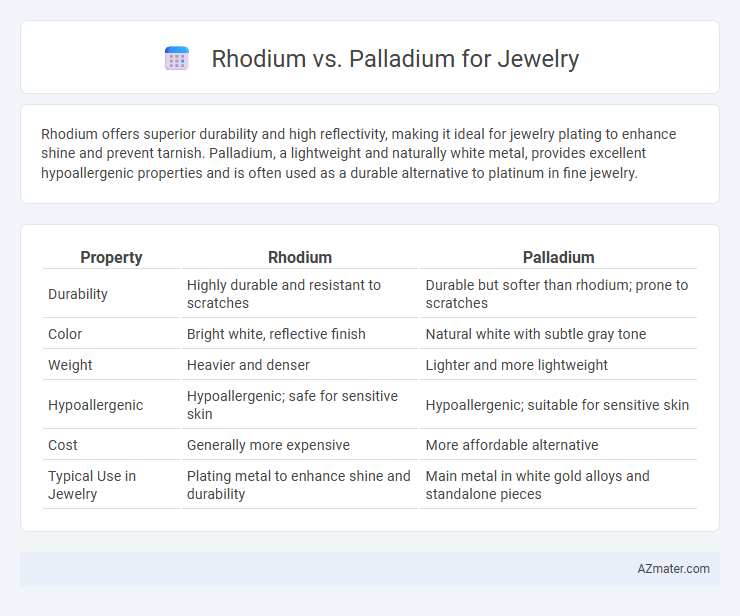Rhodium offers superior durability and high reflectivity, making it ideal for jewelry plating to enhance shine and prevent tarnish. Palladium, a lightweight and naturally white metal, provides excellent hypoallergenic properties and is often used as a durable alternative to platinum in fine jewelry.
Table of Comparison
| Property | Rhodium | Palladium |
|---|---|---|
| Durability | Highly durable and resistant to scratches | Durable but softer than rhodium; prone to scratches |
| Color | Bright white, reflective finish | Natural white with subtle gray tone |
| Weight | Heavier and denser | Lighter and more lightweight |
| Hypoallergenic | Hypoallergenic; safe for sensitive skin | Hypoallergenic; suitable for sensitive skin |
| Cost | Generally more expensive | More affordable alternative |
| Typical Use in Jewelry | Plating metal to enhance shine and durability | Main metal in white gold alloys and standalone pieces |
Introduction to Rhodium and Palladium in Jewelry
Rhodium and palladium are both precious metals used extensively in fine jewelry for their durability and lustrous finish. Rhodium, a member of the platinum group metals, is renowned for its brilliant white sheen and is commonly applied as a plating to enhance the appearance and scratch resistance of white gold and silver jewelry. Palladium, also part of the platinum family, serves as a naturally white metal alloy in white gold or as a standalone metal, valued for its lightweight nature, hypoallergenic properties, and resistance to tarnish.
Physical Properties: Rhodium vs Palladium
Rhodium and palladium, both members of the platinum group metals, exhibit distinct physical properties crucial for jewelry applications. Rhodium is harder and more reflective, offering superior durability and a brilliant, mirror-like finish that resists tarnishing and corrosion. Palladium is lighter and slightly more malleable, providing excellent scratch resistance and hypoallergenic qualities while maintaining a strong, white metal appearance ideal for intricate designs.
Appearance and Color Differences
Rhodium has a brilliant, reflective white finish that enhances the brightness of white gold and platinum jewelry, giving it a sleek, mirror-like appearance. Palladium, by contrast, possesses a naturally white hue with a subtle grey tint, offering a slightly warmer tone that can appear more understated in comparison to rhodium's high shine. The choice between rhodium and palladium influences the overall aesthetic, with rhodium plating commonly used to achieve a highly polished, reflective surface, while palladium is favored for its durable, naturally lustrous finish.
Durability and Wear Resistance
Rhodium offers superior durability and exceptional wear resistance, making it highly effective as a plating material for jewelry to prevent tarnishing and scratches. Palladium, part of the platinum group metals, also provides excellent strength and corrosion resistance but is generally softer and more prone to surface wear than rhodium. Choosing rhodium plating enhances the longevity and luster of white gold and silver pieces, while palladium's natural hardness suits solid jewelry with a slightly warmer tone.
Hypoallergenic Qualities and Skin Sensitivity
Rhodium is highly valued in jewelry for its superior hypoallergenic properties, making it ideal for sensitive skin as it rarely causes allergic reactions. Palladium, a member of the platinum group metals, also offers excellent hypoallergenic qualities but can sometimes cause mild sensitivity in those with extreme metal allergies. Both metals resist tarnishing and corrosion, but rhodium's naturally inert surface provides better protection for sensitive skin, often used as a plating over white gold or silver to enhance durability and skin compatibility.
Tarnish Resistance and Maintenance
Rhodium offers superior tarnish resistance compared to palladium, making it an ideal choice for jewelry that maintains a bright, reflective finish over time without frequent polishing. Palladium is naturally resistant to corrosion but may develop a dull patina with prolonged exposure to air and skin oils, requiring occasional cleaning to preserve its luster. Rhodium plating is often applied to white gold and silver jewelry to enhance durability and tarnish resistance, while palladium jewelry benefits from its lower maintenance requirements relative to other metals but still demands periodic care.
Cost Comparison: Rhodium vs Palladium
Rhodium is significantly more expensive than palladium, with prices often exceeding palladium by several times due to its rarity and demand in high-end plating applications. Palladium offers a more affordable option for fine jewelry, maintaining durability and a bright white finish at a lower cost. The price gap between rhodium and palladium can influence consumers' choice, especially for large or custom-designed pieces where metal cost is a major factor.
Popular Uses in Jewelry Design
Rhodium is prized in jewelry design for its brilliant white finish and exceptional resistance to tarnish, making it a popular choice for plating white gold and enhancing the shine of diamonds. Palladium, a member of the platinum group metals, is favored for crafting lightweight, durable rings and wedding bands with a natural white sheen that requires less maintenance than rhodium plating. Both metals are essential in high-end jewelry for their hypoallergenic properties and ability to preserve the longevity and aesthetic appeal of fine pieces.
Environmental and Ethical Considerations
Rhodium and palladium, both used in fine jewelry, differ significantly in environmental and ethical impacts. Rhodium mining often involves scarce resources and energy-intensive processes, leading to higher carbon emissions and ecological disruption, while palladium extraction generally has a lower environmental footprint but may still involve questionable labor practices in some regions. Ethical sourcing initiatives and recycling programs are critical to minimizing the negative impacts of both metals in the jewelry industry.
Choosing the Right Metal for Your Jewelry
When choosing between rhodium and palladium for jewelry, consider rhodium's exceptional hardness and brilliant white finish that enhances durability and resists tarnishing, making it ideal for plating over white gold. Palladium, a naturally white and lightweight precious metal, offers hypoallergenic properties and lasting resistance to wear without the need for plating, preferred for solid jewelry pieces. Evaluating factors like budget, desired appearance, and maintenance needs ensures selecting the right metal for enduring beauty and comfort in fine jewelry.

Infographic: Rhodium vs Palladium for Jewelry
 azmater.com
azmater.com